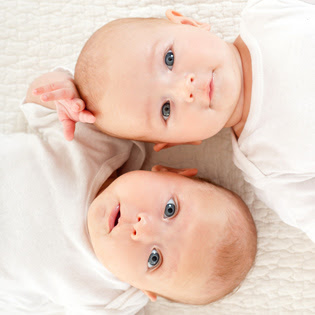It's important to understand your birth options if you are expecting more than one baby.
Twins and triplets are more likely to be born early and need special care after birth than single babies.
Your birth choices with twins
It's a good idea to discuss your birth options with your midwife or consultant early on in your pregnancy.
You'll probably be advised to give birth in a hospital as there's a higher chance of complications with twins.
There are usually more health professionals at a multiple birth – for example, there may be a midwife, an obstetrician and two paediatricians: one for each baby.
For more information on who's who, read about the antenatal team.
The process of labour is the same, but your babies will be closely monitored. To do this, an electronic monitor will usually be strapped to your bump.
A scalp clip may be fitted to the first baby once your waters have broken. This won't harm them or hurt them in any way.
You will be given a drip in case it is needed later – for example, to restart contractions after your first baby is born.
Triplets or more babies are almost always delivered by a planned caesarean section.
Can you have a natural birth with twins?
Lots of women think they have to have a caesarean section with twins. In fact, more than 40% of all twins are born vaginally and the process is similar to that of a single baby.
If you're planning a vaginal delivery, it's usually recommended that you have an epidural for pain relief.
If there are any problems, it's easier for your antenatal team to deliver your babies quickly if you've already had an epidural.
Find out more about the signs and stages of labour.
You're more likely to have a vaginal birth if the first twin is in a head-down position (cephalic).
However, there may be other medical reasons why this isn't possible. If you've had a caesarean section before, for example, it's not usually recommended that you have a vaginal birth with twins.
If you have a vaginal birth, you may need an assisted birth. This is where a suction cup (ventouse) or forceps are used to help deliver your babies.
Once the first baby is born, your midwife or doctor will check the position of the second baby by feeling your tummy and doing a vaginal examination. They may also use an ultrasound scan.
If the second baby is in a good position, it should be born soon after the first as the cervix is already fully dilated. If contractions stop after the first birth, you may be given hormones via a drip to restart them.
Caesarean section and twins
In the UK, more than half of twins and almost all triplets are delivered by caesarean.
You may choose to have a planned caesarean, or your doctor may recommend a caesarean for medical reasons.
If the first baby is lying feet, knees or buttocks first (breech position), or one twin is lying sideways (transverse position), you will have to have a caesarean section.
There are other conditions that make it more likely that you will have a caesarean section. For example, you may need one if you have a low-lying placenta (placenta praevia) or if your twins share a placenta (monochorionic).
Find out more about what complications can affect the placenta.
If you have had a difficult delivery with a single baby before, you may be advised to have a caesarean section with twins.
As with any pregnancy, if you plan a vaginal birth, you may still end up having an emergency caesarean.
This could be because the babies become distressed, for example, or the cord falls into the birth canal ahead of the baby (prolapses).
The Royal College of Obstetricians and Gynaecologists (RCOG) has more information on umbilical cord prolapse in late pregnancy.
In very rare cases, you may deliver one twin vaginally and then need a caesarean section to deliver the second twin. This happens in less than 5% of twin births.
Finding out if your twins are identical
After the birth, your midwife will examine the placenta to check that it's all there and look at the membranes.
If your babies have a single placenta with one outer membrane (chorion) and two inner membranes (amnion), they must be identical (monozygotic).
Otherwise, the only way to tell if they're identical is through DNA testing. This isn't available on the NHS.
source: http://www.nhs.uk/conditions/pregnancy-and-baby/pages/giving-birth-to-twins.aspx




No comments:
Post a Comment